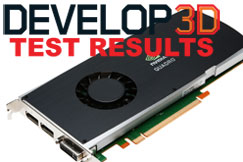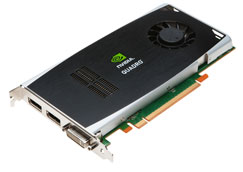The professional graphics card is one of the most critical parts of a 3D CAD/CAM/CAE workstation, without it we’d lose the fluency of working in 3D as parts and assemblies clunked about on screen.
There are two key players that operate in this sector: Nvidia, that develops the Quadro FX cards sold by PNY, and AMD, which produces the ATI FirePro family. Every two or so years both vendors refresh their product families, basing the new cards on technology that has filtered down from the consumer 3D games market.

Click on the image to find out how the latest PNY cards rated in our tests
While the core technology is the same across both lines, the professional cards are enhanced with features such as anti-aliasing (used to smooth lines) and most importantly the drivers are tuned and certified to work with all of the major CAD/CAM/CAE applications.
Last year AMD updated its entire family of professional cards and with it replaced the long-standing FireGL brand with FirePro. Soon after, Nvidia launched new high-end and ultra high-end cards (the Quadro FX 4800 and Quadro FX 5800), but it’s not until now that the company has delivered new products at the entry-level and mid-range sectors of the market – sectors that are specifically suited to CAD applications.
There are four new cards in total: the entry-level Quadro FX 380 and FX 580, the mid-range FX 1800 and the high-end FX 3800. These replace the FX 370,
FX 570, FX 1700 and FX 3700.
Processors and memory
Moving up the range from the FX 380 to the FX 3800, each card features more parallel processors and more memory.
The Quadro FX 380, for example, has 16 processors and 256MB RAM, while the Quadro FX 3800 has 192 processors and 1GB RAM. It would be nice to think that 3D performance was directly proportional to the amount of processors, but this is never the case. While some applications respond well to more processing power, others are limited by the speed of the CPU and no amount of additional graphics power will make models rotate more smoothly on screen. Autodesk Inventor is a prime example of such an application, while NX, on the other hand, makes much better use of more powerful graphics cards.
Memory is likely to become increasingly important for CAD in the coming years, particularly as more applications take advantage of Vertex Buffer Objects (VBOs). SolidWorks and Catia are among the applications already utilising this technology, which loads up geometry to the graphics card memory to improve performance.The idea is that cards with more memory can offer better 3D performance with larger models.
On test
We tested Nvidia’s new Quadro FX cards under our standard application test suite of Inventor 2009, 3ds Max Design 2009, and SolidWorks 2009. For a level playing field, a single test machine was used, provided by specialist system builder, Workstation Specialists – workstationspecialists.com (previously known as CAD2). It featured a powerful Core i7 940 (2.93GHz) processor, 6GB RAM and Windows XP X64 Edition.
No group test would be complete without direct comparison to the competition, so we also tested AMD’s low to mid-range FirePro cards. To round things off we threw in a previous generation Nvidia Quadro FX 1700, with one eye on comparing the results to the FX 1800, which is its direct replacement.
Inventor 2009: Under Inventor 2009 all of the benchmark scores were the same. In fact the only reason we use this application is to demonstrate to readers that they don’t need to spend a lot of money on a card to run Inventor and money is better spent on a faster CPU. However, We have heard on the grapevine that this could be set to change soon, so stay tuned.
SolidWorks 2009: The SolidWorks test model was updated specifically for this article so the scores cannot be compared to previous results in DEVELOP3D. This particular test model, of a digital SLR camera, uses SolidWorks’ real time rendering technology (RealView) to good effect and shows good performance scaling moving up from the low-end to the high-end cards.

Nvidia’s Quadro FX 1800 is a huge improvement over the FX 1700 and offers excellent performance under 3ds Max Design and SolidWorks 2009
In specifics, the Quadro FX 3800 came out a clear leader, though one would expect that from a card of this price. The FX 1800 also delivered excellent performance for almost half the price and was a vast improvement over its predecessor, the FX 1700. At the entry-level, however, it was the £109 ATI FirePro V3750 that impressed, offering unrivalled price/performance out of all the cards on test. Its younger brother, the ATI FirePro V3700, was extremely disappointing though.
It should be noted that for certain larger datasets, particularly those that were created in older versions of SolidWorks, we found no benefit in the higher performance cards as the models are throttled by the CPU, just like they are in Inventor.
3ds Max 2009: This graphics intensive application showed off the performance of the Nvidia cards, which is much improved for this new generation. The Quadro FX 3800, FX 1800 and FX 580 took the top three spots ahead of all the ATI FirePro cards. While all three cards performed well, the additional memory in the FX 1800 and FX 3800 will be of particular interest for those that use large, detailed textures.
Conclusion
Buying a graphics card for CAD is a complex process as perfomance can vary greatly from application to application and also from dataset to dataset. The card that stood out for us is the Quadro FX 1800 and the good scores it delivered under our SolidWorks and 3ds Max benchmarks certainly show its pedigree, but that doesn’t mean it will benefit everyone.
Those working with certain large datasets in SolidWorks may experience similar performance with a Quadro FX 580 or FX 380, as the CPU can become the bottleneck instead of the graphics card. In this instance investing in a faster CPU would offer more benefit.
In direct relation to our test results, the surprise package was AMD’s FirePro V3750, which delivers excellent performance under SolidWorks, which will be of particular interest to those on a tight budget.
We take a closer look at 3D graphics inside SolidWorks 2009 here.
Display interfaces explained
There are two types of display interfaces supported on the new Quadro FX cards: Dual Link DVI and DisplayPort. It’s quite important to know the difference as this could have an impact on users who wish to use dual monitors, particularly at high-resolutions.

The Dual Link DVI standard is found on virtually all professional TFT displays and supports resolutions up to 2,560 x 1,600, as sported by Apple’s 30-inch Cinema Display. It’s primarily a digital standard, but also transmits an analogue signal and via a VGA adapter included in the box with all Quadro FX cards, can be used with CRT monitors or cheaper TFTs (though quality is worse).
DisplayPort is the new display standard, and is digital only. It’s still not widespread in TFT displays, but can support extremely high resolutions up to 3,840 × 2,160. It can work with analogue monitors, but a dedicated converter with active circuitry is required. These cost around £50 a unit.
Problems can arise if you want to run two dual link DVI, 2,560 x 1,600 resolution displays at the same time. This is fine on the Quadro FX 380, but not on the FX 580 and above. This is because the DisplayPort to DVI converter can’t do more than 1,920 x 1,200. This also applies to most ATI FirePro cards.
In summary, DisplayPort certainly looks to be the future of display technology, and will drive forward in the coming years, but beware of limitations when working with dual monitors that don’t support the standard.






